Further Expanding the Building Infrastructure
Four years later, the continuing growth of the school necessitated the construction of the gymnasium and the 300 wing. Various make-shift arrangements had provided space until then; a Quonset hut and a trailer home had served as classrooms. In 1970, the 400 wing was built, connecting the gym and the 300 wing, and providing adequate cafeteria space. Prefabricated buildings were added in 1972, 1976, and 1982. A small building which housed three Brothers for a short time became the Faculty House, with a portion of the space set aside for an art studio; the typing room had been in the basement of the house for several years. Renovations in the basement of the Administration Building added classroom space, and increased the bewilderment of Freshmen who found they had to go out one of the side doors and re-enter by another in order to find the computer room.

The Atmosphere of St. Anthony’s
Part of the atmosphere of St. Anthony’s has derived from this rather haphazard scattering of buildings about the western portion of the campus. Hurrying from class to class meant moving from building to building, in all sorts of weather, some boys with warm jackets, others in their shirt sleeves, most of them eating a snack. Formal lunch periods have not been a priority, and the attempt to insist on them has usually been met by a plea to substitute a period of chorus or even calculus.
Another factor in the spirit of the school has been the policy of permitting students to use free periods for recreation if they so choose. The lunch period, for those who have one, is often a study time, but any free period has also been used for basketball on the outdoor courts, for touch football, for throwing a Frisbee, for draping oneself on a fence or a picnic table to talk with friends.
Faculty Growth
As the school grew in other ways, the faculty, too, had to grow, and it was no longer possible to staff the school entirely with Brothers. Of course, the coaches and Physical Education teachers had been laymen from the beginning of the day school, with Archie DeMarco, for whom the baseball diamond was eventually named, as one of the earliest. Now the percentage of lay faculty members increased, and came to include women as well as men. The first Sister, Sister Berchmans, OSU, joined the Religion Department in 1974, followed by six more Sisters, representing three Orders, the following year.
Curriculum Changes
Changes in curriculum have met the needs of a changing world, especially by the addition of computer courses and Advanced Placement courses. Business subjects were introduced when Vincent Tenety, the father of two students, went blind. An experienced accountant, he asked Brother Venard to allow him to teach accounting to juniors and seniors, because he did not wish to be without any occupation, and he was not a person to succumb to self-pity. His example was an inspiration for every student and for every faculty member. After his death, the accounting course was discontinued, but in the meanwhile, typing had been added.
The End of an Era
When Bishop McGann celebrated the Golden Jubilee Mass on Sunday, September 18, 1983, none of the thousands who gathered on Cy Donnelly Field for the Mass and the champagne brunch that followed realized that an era was ending. Three months later, on December 5, the Bishop called a press conference to announce extensive changes in the educational structure of the diocese. As part of these changes, Holy Family Diocesan High School would close at the end of June, 1984, and St. Anthony’s would re-locate in the Holy Family facility in South Huntington. At three o’clock, while the Bishop was making his announcement, Brother Hugh McGrath, Principal of St. Anthony’s, held a brief faculty meeting to make the expected announcement (rumors had been flying for several weeks) and to answer questions. The following morning he made the formal announcement to the students, reminding them that their sense of loss could not be as great as that of Holy Family students.
As this history is completed, therefore, we are forced into the awareness that history can never be considered complete. The problems of transition lie ahead. Two schools which have been keen rivals in sports, must learn to blend into one. But if school spirit is more than a matter of broad fields and white fences, if it is truly a matter of the heart, it will not only survive, but will grow stronger.
